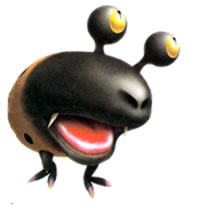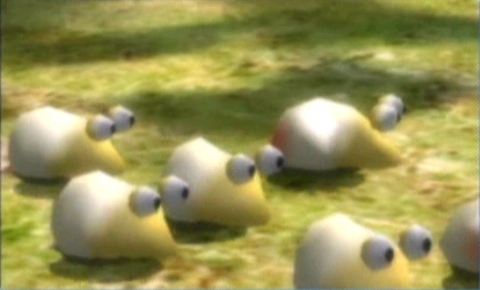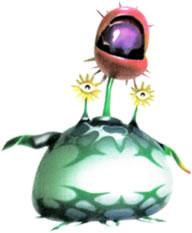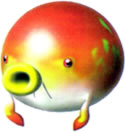NOTE: This profile assumes that "size scaling" is firmly in place. Ergo, enemies that should be smaller than a human being are much, much larger. Hocotanians are assumed to be around 4 feet in height, and everything is scaled from there.
.png)
Geographical Features: - this is one of many variations of planet Earth that exist throughout the multiverse. In this one, humans died off to unknown sources at some unspecified moment in the past. For this reason, it is largely identical to our Earth, albeit with very different flora/fauna.
It contains all 7 major continents, still largely divided into the biomes as we know them today. The polar caps are intact, as are the oceans, mountains, and major deserts. The planet also seems to contain the same mineral resources.
The most unique exports available from this planet consists of a massive supply of fruit and other kinds of food, as well as a surprising cache of super weapons.
Third Party Factions: 2
--The Wraiths: An enigmatic and rare species, the Wraiths currently have only 2 representatives, who might actually be the same entity. This consists of the Water Wraith and the Plasma Wraith.
The Water Wraith is the first Wraith to have been observed. Characterized by its water-like, shiny body and large stone rollers, it is extremely mysterious. Theories hold that it is a psychic phenomena; the Hocotanian Ship declared it to be an entity whose physical form was anchored in another dimension. This renders it largely immune to conventional attacks. Sudden blunt trauma will temporarily anchor it, allowing it to be harmed. (although it cannot be killed)
It exudes a fear aura that is severe enough to drive even veteran space travelers nearly to madness, and consumption of any part of it leads to mass hysteria and spasms. This creature is virtually an Eldritch abomination in all but looks.
It is significantly larger than a Bulborb and relies on its rollers to attack. Without them it is apparently useless in combat.
The Plasma Wraith is a mysterious lifeform of unknown intent. It seems entirely obsessed with Captain Olimar, going so far as to kidnap him. However, it reacts violently to anyone else approaching it or its prisoner, making this a very dangerous creature indeed.
Because of its semi-liquid state of existence, this creature is incredibly difficult to defeat. In the final battle, it was not even killed, just weakened and driven off temporarily. This would seem to indicate that so long as any tiny piece of the creature is alive, it will continue existence. If plasma is knocked off of it, the pieces can be easily reabsorbed to heal itself.
It has the ability to harness all of the main elements of the Pikmin games. It can turn into water, ignite fires, control electricity, and create a defensive glass shield. It can also fly. This means that it is one of only 2 creatures to employ the major elements all at once, the other being the Titan Dweevil.
--The Wildlife: The most dangerous part of this planet is the super-fauna and in some cases, the super-flora.
-Bulborbs: There are 4 major variations of the standard Bulborb. This includes the:
Spotted or Red Bulborb, which is incredibly common and around the size of a Tyrannosaurus Rex. Because of this, they have no natural predators and often leave themselves exposed while sleeping. However, their bulk, numbers, and environmental diversity make them a major force of their own. All stats applied to the Red Bulborb can be applied to the other variations except their sleeping habits.
Bulborbs have enough bite force to not only lift multiple purple pikmin and rock pikmin, but have shown the ability to damage the Hocotanian suits (which are capable of impressive damage soak). Naturally, their massive size only augments their potential bite force. They show impressive damage soak as well. Pikmin are "superhuman" for their size, and only large swarms of 50 or more Pikmin really pose a threat to these beasts.
Their large, stalked eyes present a slight weakness, although they seem to operate more on smell than anything (nocturnal nature seems to reinforce this theory) and of course their comically small legs are an easy target as well, if you can dodge the jaws.
Also of note: Bulborbs are generally found near clusters of 3 to 5 Dwarf Bulborbs. While some of these dwarfs are offspring of the Bulborbs, others are Breadbug mimics. Either way, the Bulborb will come to the aid of a distressed dwarf, and a dwarf will aid the parent as well.
Hairy or Snowy Bulborbs are not radically different than Spotted ones, although they have a mass of hair on their hindquarters, an adaptation which aids their survival in colder regions. They are found almost exclusively in frigid caverns and seem to be followed by fewer young, which may indicate that they are a rarer, slower breeding species (which would make sense).
Orange Bulborbs, while nocturnal much like the others, sleep more carefully, and wake up when enemies draw near. This gives them blood shot eyes and makes them more dangerous than most during the day. Orange Bulborbs are also extremely common underground compared to other species, even outnumber the Hairy Bulborb in cavern colonies.
Orange Bulborbs also seem to attract larger groups of dwarfs than the others, which only increases their danger level. Overall, the Orange Bulborb is the most dangerous of the Bulborbs.
Finally, the Whiptongue Bulborb, which is characterized by an anteater like tongue, which it uses to snatch up to 5 Pikmin at once, devouring them swiftly. This species poses a threat only to smaller foes, although those will be in abundance in most cases. They can even grasp up to 5 purple pikmin, which is (with size scaling) nearly a ton in weight.
Also of note, while the Whiptongue lacks a dwarf form, making it more solitary than most Bulborbs, it is diurnal or possibly cathemeral.
-Water Dumple: A more recent addition to the Grub Dog ranks, and one of dubious usefulness against invaders, the Water Dumple is notable for its aquatic nature. They have no problem assailing terrestrial areas as well, but their preferred prey consists of smaller insects that land on the water. Nevertheless, they are quite large and a bit more powerful than the average Dwarf Bulborb. They also are always found in groups ranging from 2 or 3 to 5 or more.
-Bulbear: A stronger, somewhat larger variation of the normal Bulborb, they have shorter but broader jaws, which allows them to attack more quickly and powerfully than a normal Bulborb. They are more durable, with notoriously high regeneration. This regeneration is so great they can seemingly come back from the dead. Even after being pummeled to "0 hp" a Bulbear will slowly but surely rebuild its health until it is back to full. Nothing short of an explosion ripping them apart will kill them.
Unlike Bulborbs, Bulbears are not nocturnal, nor are they restrained within a small territory during the day. Rather, they wander over a massive area, patrolling it consistently until dealt with.
Bulbear's are extremely dangerous for another reason, as well. Despite being formidable singular threats, they are always followed by varying numbers of juvenile Dwarf Bulbears. Unlike Bulborbs, Dwarf Bulbears are legitimate offspring, and are much more dangerous than other dwarfs.
These are characterized by superior senses, durability, and agility compared to Bulborb dwarfs, and thus notice enemies sooner. They have demonstrated the ability to perform back flips in order to shake off attacking Pikmin. Any unclaimed Bulbear juvenile will automatically fall in line behind an adult as soon as possible, as they lack their own patrol roots. This makes it impossible to predict how many dwarfs will be following a Bulbear at any given point.
-Fiery Bulblax: The largest of the non-boss Grub Dogs. The Fiery Bulblax shares a face structure with its larger relative, the Emperor. This creature is, with or without its namesake defense, a massive threat. More health and a more vicious offense than any covered so far, this is a truly apex predator.
Naturally this creature is predominantly characterized by the aura of fire it creates. This fire is several hundred degrees at least, damaging Hocotanian suits not equipped with the Scorch Guard. This fire is formed by chemical reactions on its skin, and thus is very difficult to extinguish. It seems that the beast must be submerged at all times to put it out, as it will instantly burst back into flame. This creature is intelligent enough to recognize its fire as its greatest asset, and will avoid water like the plague.
-Empress Bulblax: A normal Bulborb grown to massive size due to pregnancy. Swollen to the size of a large building and filled with larva, this massive beast uses its bulk to crush those who attack it. Based on notes that Olimar made, any Bulborb could conceivably become an Empress, as they travel in packs and exhibit gender swapping capabilities. The larva that are spawned by the Empress are each the size of a Hocotanian as well, so in sufficient force the Empress is a small army all her own.
Her only attack is to roll at enemies, crushing them with her bulk. However, this attack hits with enough force to knock boulders down from the ceiling. Said boulders do little if any damage to her majesty.
The larva mentioned above are extremely weak, but are capable of moving at moderate speeds and attacking opponents upon birth. They are independent of their parents, being able to hunt nourishment and seem, like their adult counterparts, to prefer groups. They are seemingly on par with Pikmin in combat stats, as a larva can swallow a Pikmin whole, but a Pikmin can one shot a larva. They occasionally drop nectar upon death, which may indicate that Bulborbs drink the substance as well.
-Emperor Bulblax: Possibly the most dangerous creature on PNF-404 short of other-dimensional entities, this is the largest variation of the Grub Dog family excluding the swollen Empress. Only one full sized adult has ever been observed, although the Emperor is a threat no matter what his age.
The original Emperor is a building sized monster who attacked by flailing its massive tongue around, eating whatever stuck to it. There seems to be no upper limit to what it can lift with this tongue, as dozens of purple Pikmin barely faze it. Explosions can be used to stun the beast but have little lasting effect, and poison is utterly futile against it.
The Emperor has a few other tricks as well. If it feels threatened or has taken significant damage, it is likely to begin leaping. This terrifying process involves it leaping high into the air and smashing down onto any enemy. It can leap approximately 4 times its own length, and leaps around 1 or 2 times its own height. This is not only an attack, but a huge strength feat. Finally, the "fear roar" is a somewhat weaker, but still potent attack. Striking fear into weaker enemies, this ability summons other Bulblaxes to the fight. It may also cause Mitites to swarm out of the ground.
Its hindquarters are not only covered with massive fat stores like the rest of him, but moss, stones, and mushrooms grow upon the beasts back, making it impenetrable to most attacks. Its face, while more vulnerable, is still incredibly durable. Its legs are also seemingly immune to assault, much like its back. Even if one were to attack these legs, the Emperor would simply jump, crushing opponents.
Finally, the Emperor is an ambush predator, with incredible camouflage and super fast burrowing. It also is somewhat amphibious, generally preferring moist environments, and can often be found buried underwater. They may also be responsible for digging out some of the caverns (most notably the Bulblax Kingdom) in Pikmin 2.
--Dweevils: Another very common denizen of PNF-404, Dweevils are characterized by their massive strength and defensive habits that involve scavenging carcasses to mimic. They have 5 major variations and one boss.
-Caustic Dweevil: Blue, unique in its use of powerful spacesuit corroding acid to attack enemies.
-Fiery Dweevil: Red, unique in its use of powerful flames to attack enemies.
-Anode Dweevil: Yellow, unique in its use of powerful electricity to attack enemies.
-Munge Dweevil: Purple, unique in its use of powerful poison vapors to attack enemies.
-Volatile Dweevil: Yellowish, unique in its use of a massive bomb on its back which it detonates to destroy itself and its enemy. This explosion is approximately the same power as a standard bomb rock (Pikmin 2 variation), putting it at possibly small building busting.
-Titan Dweevil: Currently in use by the Hocotanian Army. See the Pikmin Army Profile for details.
--Arachnorbs: Silicon based lifeforms that look similar to spiders. 3 of the 4 species are notable for their large, flat feet and long legs. This combination allows them to smash most enemies into paste. They live high above the forest/cave floor, and drop down onto their enemies. Raging Long Legs are often filled with Mitites as well.
As said, they are silicon based lifeforms. Upon death, their bodies spontaneously erupt into flames and fall apart, making study difficult. They may also be intelligent. The Raging Long Legs is noted to be clearing an area for some unknown purpose.
-Man at Legs: The most notable Arachnorb, this one entered into a symbiotic relationship with a mysterious machine at some point in the past. This machine retrofitted the Arachnorb with metal armor, a robotic leg, and a powerful, fast shooting, laser guided, explosive launching gun. This makes it one of the most powerful/dangerous enemies on PNF-404.
The machine side automatically acquires targets and attempts to dispatch them. The Arachnorb side is gentle in disposition and (being so large) has no natural enemies. This leads scientists to believe that it was the machine that approached the Arachnorb with the symbiotic relationship.
--Snavians: Not as dangerous as the others, these bird/snake hybrids are nonetheless several stories high and very dangerous, easily capable of dispatching lightly armored troops.
-The Burrowing Snagret is, along with the almost identical burrowing Snarrow, the most common of the Snavians. They never draw fully from the ground, generally stay in a smaller area that they identify as their territory, and generally attack with incredibly fast, precise pecks.
-The Pileated Snagret is a larger, more dangerous variation on the average Snagret that may or may not be entirely subterranean in nature. Unlike normal Snagrets, the Pileated has a singular foot which it uses to hop around after its prey. This, combined with its larger size, makes it a dangerous force against small groups or weak opponents.
--Chrysanthemums: A relative of Pikmin, this species disguises itself as a harmless flower, springing out to attack enemies with its massive, bulb like mouth. It is surprisingly durable and quite large, but not a huge threat, generally speaking. Often found in small groups, though they exhibit no pack/herd behavior.
--Amphituber: A frog like species without too many offensive capabilities, they are nevertheless quite common and with their “Mario stomp” style of attack, could destroy small squads with ease. They are split between Yellow Wollywogs (the more common) and the underground Wollywogs, which are pale and weaker.
Wollywogs are notable in that they generally congregate near water that contains their young, using their hopping as a distraction for predators, and protecting said young from predators. This makes them fairly easily circumvented.
--Blowhogs: The descendants of pigs, they can be divided into 2 terrestrial and 2 aerial variations. The terrestrial ones consist of a fiery and a watery blowhog, one of which shoots a massive blast of flame and the other of which launches nonflammable liquid at enemies. Both shots can be fired around 3 times their body length, making them serious threats to many enemies.
The 2 aerial variations fire blasts of pressurized air to knock enemies around. Not serious threats, although they could definitely act as irritations. They maintain tight, small territories, and try to remove any enemy from this territory.
--Lithopods: Their larval forms are highly common, and appear as 4 legged grubs that fire boulders the size of small vehicles at enemies. Their adult forms are massive, building sized beetle like creatures that launch boulders as well and proved resilient to all attacks until they lift their carapace to cool off.
The Decorated Cannon Beetle as of now has no adult stage. However, it's larval stage is shown to have the same defenses as a normal cannon beetle, with one important difference. Because of the composition of its boulders, they will home in on metallic substances once fired. This could pose a huge threat to some enemies.
--Various: Basically every single enemy that can be considered a threat on this planet is around the size of a human being or more, and most are more. Elemental attacks, explosives, etc are also common. There are a few major ones I didn’t even bother listing, including the Groink, and various bosses.
Danger Status: 4/5
Although the planet is a hospitable, earth-like planet, the species that live on its surface are murderous. They range from acid/fire/lightning spitting to just flat out gigantic.







.jpg)























.jpg)


You would appear to assume that a Hocotatian is around 4 feet. However, I distinctly recall my Pikmin manual claiming captain Olimar to be around the size of your pinky. This is further supported by the fact that things which once belonged to humans appear simply massive in size compared to captain Olimar.
ReplyDelete